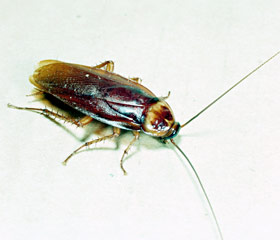American Cockroach, Periplaneta americana

Clemson University - USDA Cooperative Extension Slide Series, Bugwood.org.
IPM Steps to Reduce American Cockroaches
1. Sample for Pest
Confirm the presence of cockroaches.
Where to find it while inspecting: You will need a strong flashlight and an inspection size mirror (small and on a long handle) to do the job properly. Draw a diagram map of the area. To monitor activity, you can place sticky traps in areas where you suspect activity. It’s a good idea to mark the date you set the trap and also to note the location on your map. For American cockroaches, it is best to examine areas after dark and expect to find them near moist areas. During the day you may need to probe dark places with a thin piece of wire. You will also see “pepper-like” specks on walls near nest sites (feces). Any tight cracks make good habitat. Nymphs cast off their “skin” as they grow and this is another sign of cockroach infestation. The use of sticky traps at strategic locations is helpful; place in out of the way locations and monitor every day for a week.
2. Proper ID
Before you act, determine your pest is a cockroach and for best results, which species of cockroach.
Size and Particulars: Flattened, oval shaped insects with spiny, long legs and antennae, and wings (American cockroaches are capable of flying). American cockroaches are the largest of the house-infesting cockroaches at 1.5–2" long. They are reddish-brown.
3. Learn the Pest Biology
Knowing the life cycle helps you fight cockroach infestations.
Life Cycle: American cockroach females deposit their brown, bean-shaped egg cases in sheltered areas near the floor and a food sources. Eggs hatch in 5–7 weeks. After roughly fifteen months of development as a nymph, their adult life span is generally another fifteen months. American cockroaches are able to survive without food and water for extended periods of time.
Preferred Food Sources: Will eat most any organic matter, including decay and will feed on the starch used in papers and books.
Preferred Habitat: American cockroaches prefer dark, moist areas inside and outside and hide during the day. They forage at night and are able to run rapidly when disturbed; they can fly but it is uncommon and more of a gliding motion than true flight.
4. Determine Threshold
If you have cockroaches, you need to act.
Threshold: One cockroach almost always means more are unseen. Monitor with sticky traps or bait traps to be sure, or act now if conditions are good for infestations.
5. Choose Tactics
IPM for indoor pests is always a combination of Exclusion and Sanitation: Try to keep them out. Don’t provide water, food and shelter if they enter your building.
Best Management Practices: They key factor is sanitation and reduction in habitat. Take care not to bring them in on packaging material (inspect incoming food). Clean up all spilled foods; don’t leave dirty dishes overnight; store all food in pest-resistant packaging; modify areas where pipes and utilities enter walls (caulk and screen all entrances); reduce moisture by improving plumbing and insulating pipes that routinely sweat. Empty garbage every day. Keep floor drains capped or full of water. Increase ventilation in moist areas. Baits are the most efficient and widely used form of control, but prevention is the least toxic method of control.
Treatment Methods: Chemical control: Baits contain hydramethylnon, fipronil, sulfluramide, boric acid and abamectin can provide acceptable control. Read the label carefully before using and keep out of reach of children. Insecticidal dusts like boric acid, silica aerogel and diatomaceous can also provide control. Light applications of dust in cracks and crevices can be made, but not in areas where children have access. Baits kill actively feeding nymphs and adults but not eggs so this method will have to be maintained over a period of time. NOTE: the use of insecticide sprays and foggers is rarely effective. NOTE: boric acid can be a hazard to children if within their reach. The long egg-hatching time means treatments must be ongoing until all signs of infestations are gone. Continue to use sticky traps to monitor activity and check them often.
6. Evaluate
Was the tactic successful? Record the date pests were first noted, and the tactic you used, and its success. Use one of our recordkeeping tools.
For More Information:
Maine.gov Got Pests?: Cockroaches
Integrated Pest Management for Northeast Schools
Found a Cockroach? Saw a Gazillion?
Diagnostic Services at Michigan State University: American Cockroaches
Remember:
When a pesticide application is necessary, all necessary and required precautions are taken to minimize risk to people and the environment and to minimize risk of pesticide resistance or pest resurgence. Pesticide use in your school may be prohibited or regulated by local policies or state and federal regulations. Risk reduction methods can include, but are not limited to, spot-treatment, the use of gel or paste bait formulations placed in inaccessible locations, injection into a crack or crevice, and other methods that reduce potential exposure.